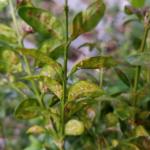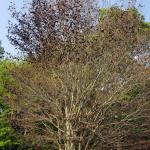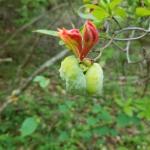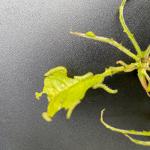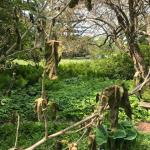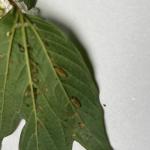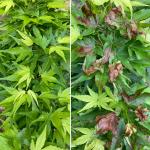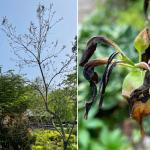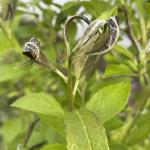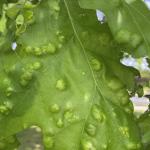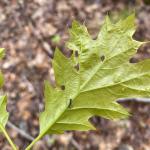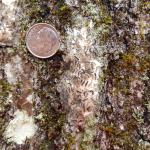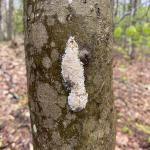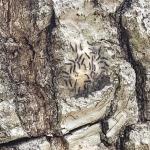UMass Extension's Landscape Message is an educational newsletter intended to inform and guide Massachusetts Green Industry professionals in the management of our collective landscape. Detailed reports from scouts and Extension specialists on growing conditions, pest activity, and cultural practices for the management of woody ornamentals, trees, and turf are regular features. The following issue has been updated to provide timely management information and the latest regional news and environmental data.
Thanks for your continuing interest! To receive immediate notification when the next Landscape Message update is posted, be sure to join our e-mail list
To read individual sections of the message, click on the section headings below to expand the content:
Scouting Information by Region
Environmental Data
The following data was collected on or about May 24, 2023. Total accumulated growing degree days (GDD) represent the heating units above a 50ºF baseline temperature collected via regional NEWA stations (http://newa.cornell.edu) for the 2023 calendar year. This information is intended for use as a guide for monitoring the developmental stages of pests in your location and planning management strategies accordingly.
|
MA Region/Location |
2023 Growing Degree Days |
Soil Temp |
Precipitation |
Time/Date of Readings |
||
| Gain since last report |
2023 total |
Sun |
Shade |
|||
|
CAPE |
29 |
233 |
62 |
55 |
1.27 |
12:00 PM 5/24 |
|
SOUTHEAST |
10 |
231 |
78 |
57 |
3.10 |
2:45 PM 5/23 |
|
NORTH SHORE |
29 |
212 |
57 |
51 |
2.42 |
9:30 AM 5/23 |
|
EAST |
41 |
283 |
71 |
59 |
1.39 |
4:00 PM 5/24 |
|
METRO |
40 |
240 |
56 |
51 |
2.49 |
5:15 AM 5/24 |
|
CENTRAL |
52 |
272 |
58 |
54 |
1.31 |
10:30 AM 5/24 |
|
PIONEER VALLEY |
68 |
277 |
64 |
57 |
1.94 |
12:30 PM 5/24 |
|
BERKSHIRES |
46 |
207 |
60 |
54 |
1.04 |
n/a |
|
AVERAGE |
39 |
244 |
63 |
55 |
1.87 |
- |
|
n/a = information not available |
||||||
US Drought Monitor: The Cape and the islands, as well as parts of Southeastern MA classified as "D0: Abnormally Dry" as of Thursday 5/25: https://droughtmonitor.unl.edu/CurrentMap/StateDroughtMonitor.aspx?MA
Phenology
| Indicator Plants - Stages of Flowering (BEGIN, BEGIN/FULL, FULL, FULL/END, END) | ||||||||
|---|---|---|---|---|---|---|---|---|
| PLANT NAME (Botanic / Common) | CAPE | S.E. | N.S. | EAST | METRO W. | CENT. | P.V. | BERK. |
|
Cotinus coggygria (common smokebush) |
* |
Begin |
* |
* |
* |
* |
* |
* |
|
Weigela florida (old fashioned weigela) |
Full |
Full |
Begin/Full |
* |
* |
Full |
Full |
* |
|
Robinia pseudoacacia (black locust) |
Begin |
Full |
Full |
Full |
Full |
Full |
Full |
* |
|
Syringa meyeri (Meyer lilac) |
Full |
Full/End |
Full |
Full |
Full |
Full |
Full |
Full |
|
Deutzia spp. (deutzia species) |
Begin |
End |
Begin |
Full |
* |
Full |
Full |
Begin |
|
Aesculus hippocastanum (common horsechestnut) |
Full |
End |
Full |
Full |
Full |
Full |
Full |
Full |
|
Enkianthus campanulatus (redvein enkianthus) |
Full |
Full |
Full |
Full |
Full |
Full |
Full |
* |
|
Rhododendron carolinianum (Carolina rhododendron) |
Full |
* |
End |
Full/End |
Full |
Full |
Full |
Begin/Full |
|
Rhododendron catawbiense (catawba rhododendron) |
Begin |
Full |
* |
Full |
Full |
Full |
Full |
* |
|
Spiraea x vanhouttei (Vanhoutte spirea) |
Full/End |
End |
Full |
Full/End |
Full/End |
Full/End |
Full/End |
Full |
|
Elaeagnus umbellata (autumn olive) |
End |
End |
Full |
End |
Full/End |
Full/End |
Full/End |
Begin/Full |
|
Syringa vulgaris (common lilac) |
Full/End |
End |
Full |
End |
End |
End |
End |
Full |
|
Cornus florida (flowering dogwood) |
Full |
End |
Full |
Full/End |
Full |
End |
Full/End |
Full/End |
| * = no activity to report/information not available | ||||||||
Regional Notes
Cape Cod Region (Barnstable)
General Conditions:
The average temperature for the period from May 17 thru May 24 was 54ºF with a low of 36ºF on May 24 and a high of 71ºF on May 21. The period was pleasant with mostly sunny days, except for May 20 which was mostly cloudy. Precipitation occurred on May 20 & 21 totaling just over one and a quarter inches. The precipitation was much needed as abnormally dry conditions persist. Soil moisture is short.
Herbaceous plants in bloom include bearded iris (Iris x germanica), lupine (Lupinus spp.), columbine (Aquilegia spp.), solomon’s seal (Polygonatum odoratum). Woody plants seen in bloom include crabapple (Malus spp.), holly (Ilex opaca), Carolina silverbell (Halesia carolina), fothergilla (Fothergilla gardenii), snowball viburnum (Viburnum opulus). Tree pollen, primarily white oak, and grass pollen are abundant.
Pests/Problems:
Inquiries about damaged and non- or lesser blooming plants are ongoing, including hydrangea, butterfly bush, several Prunus species, azalea, rose, and crapemyrtle. Inquiries about dead or damaged arborvitae and rhododendron are also common – the primary cause is most likely drought damage from last season.
Fall cankerworm, winter moth, and spongy moth have been observed feeding on various trees. Other insects or insect damage observed during the period include eastern tent caterpillar on black cherry, viburnum leaf beetle on arrowwood, dogwood sawfly larvae on alternate leaf dogwood, boxwood leafminer emerging from boxwood, red lily leaf beetle damage on Asiatic lily, elder shoot borer on elderberry (Sambucus nigra), and white grubs in turf.
Beech leaf disease is being seen both in American beech and European beech. The severity of symptoms ranges drastically, with some beeches having extensive bud damage with little to no leafing out. Disease symptoms or signs observed during the period include exobasidium gall on deciduous azalea, leaf spot on mountain laurel, shot hole disease on cherry laurel, brown rot on flowering cherry, and sycamore anthracnose on sycamore.
Weeds seen in bloom during the period include autumn olive (Eleagnus umbellatum), bush honeysuckles (Lonicera spp.), garlic mustard (Alliaria petiolata), Asian bittersweet (Celastrus orbiculatus), winged euyonmus (Euonymus alatus), common cinquefoil (Potentilla simplex), thymeleaf speedwell (Veronica serpyllifolia), common violet (Viola sororia), black medic (Medicago lupulina), white clover (Trifolium repens), and cypress spurge (Euphorbia cyparissias).
Rabbits are abundant.
Keep yourself protected from ticks.
Southeast Region (Dighton)
General Conditions:
Wonderful spring weather continues unabated. We even had a gentle rainstorm over the weekend delivering some relief from the dry conditions. Still, we've only had three quarters of the average precipitation expected in May. We started the period with warnings of both fire and frost. The fire risk was high due to strong winds and very dry conditions. We ran the risk of frost on the morning of Thursday, May 18th, with a low here of 33ºF, although in some areas it was colder. The high temperature for over the past seven days was 70ºF on Tuesday, the 21st. The average temperature was 54ºF. Winds were in gusts as high as 36 mph.
Plants in flower: Achelia (yarrow), Allium (ornamental onion), Aquilegia (columbine), Chionanthus virginicus (fringetree), Clematis, Convallaria majalis (lily-of-the-valley), Cornus kousa (Kousa dogwood), Cotinus coggygria (smokebush), Deutzia, Dianthus (pinks), Dicentra formosa (western bleeding heart), Enkianthus campanulatus, Euonymus alatus (burning bush), Hesperis matronalis (dame's rocket), Iris germania (bearded iris), I. pseudacorus (yellow flag), Iris sibirica (Siberian iris), Kalmia latifolia (mountain laurel), Leucanthemum × superbum (Shasta daisy), Lonicera (invasive bush honeysuckle), Lupine (bluebonnet), Nepeta (catmint), Nymphaea (waterlily), Ornithogalum umbellatum (star-of-Bethlehem), Paeonia (peony), Papaver orientale (Oriental poppy), Philadelphus (mock-orange), Phlox subulata, P. stolonifera (creeping phlox), Physocarpus (ninebark), Polygonatumm biflorum (Solomons-seal), Salvia (sage), Rhododendron catawbiense (rosebay, Catawba hybrids), Robinia pseudoacacia (black locust), Rosa rugosa (beach rose), Rubus (raspberry, bramble), Salvia (sage), Spiraea prunifolia (bridal wreath), Syringa pubescens subsp. patula 'Miss Kim' (Miss Kim Korean lilac), Tilia (linden), Tradescantia (spiderwort), Viburnum dentatum (arrowwood viburnum), V. plicatum (double-file viburnum, snowball viburnum), Weigela.
Pests/Problems:
Beech leaf curl due to heavy beech aphid infestation observed. Eastern pine sawfly is still active; they've stripped off last year's needles and are devouring the new candles. The emerald ash borer is moving rapidly through the area; dead and dying ash are all too obvious. Rhizosphaera needle cast on red spruce observed. Lint from cottonwood is beginning to float on the wind. Pollen is still fairly heavy and inducing itchy eyes and sneezing. Despite a deep, penetrating rainstorm on Saturday, May 20, thru Sunday morning, drought is still a threat. Don't neglect the danger of ticks when working in the field.
North Shore (Beverly)
General Conditions:
After two weeks of dry weather conditions with no precipitation, a rain storm passed through on Saturday and Sunday bringing a soaking rainfall to the area. A total of 2.42 inches of rainfall was recorded at Long Hill. Otherwise, the weather most of the days during this reporting period was clear and sunny with little cloud cover. Temperatures were very seasonable for this time of the year except for May 18 when night temperatures went down to 31ºF. Daytime temperatures ranged from the mid 50s to the low 70s and nighttime temperatures ranged from the mid 40s to low 50s. The average daily temperature was 54ºF with a high of 73ºF recorded on May 21 and a low of of 31ºF recorded on May 18. Conditions were very conducive for outdoor activities and landscape work most days of the week. Woody plants seen in bloom include: many azaleas and rhododendrons, Constellation Rutgers flowering dogwood (Cornus rutgersensis), common lilac (Syringa vulgaris), doublefile viburnum (Viburnum plicatum var. tomentosum), slender deutzia (Deutzia gracilis), little leaf lilac (Syringa microphylla), sapphireberry (Symplocos paniculata), American cranberrybush viburnum (Viburnum trilobum), umbrella tree (Magnolia tripetala), mock orange (Philadelphus coronarius), pearlbush (Exochorda racemosa), and tree peony (Paeonia suffruticosa). Herbaceous plants in bloom include: Scotch rose (Rosa spinosissima), Father Hugo rose (Rosa hugonis), columbine (Aquilegia canadensis), Japanese primrose (Primula japonica), Allium (Allium spp.), honesty plant (Lunaria annua), trillium (Trillium spp.), vinca vine (Vinca major), and fetterbush (Leucothoe fontanesiana).
Pests/Problems:
Azalea sawfly was observed causing damage on some azaleas. The larvae are green and closely match the leaf color. They feed on leaves at the tips of twigs and branches, leaving only the midribs. Leaf and flower gall disease (Exobasidium vaccinii) was observed in azalea. The fungus causes cells in leaf and flower tissue to multiply rapidly, forming large fleshy galls. The disease can be controlled by hand picking the galls and burning or burying them. To prevent new infections, pick the galls before the white spore layer on the surface appears. Rose sawfly was observed causing damage to rose bushes. If larvae are discovered when they are still young, they can be easily controlled with an insecticidal spray - make sure to spray both sides of the leaves. The larvae of viburnum leaf beetles (Pyrrhalta viburni) are getting larger and starting to cause damage on the leaves of susceptible Viburnum cultivars. The freezing temperatures that occurred on May 18 have caused freeze damage on young growth of some plants, including Taxus and Ilex. Weeping cherry, Japanese stewartia, and dove trees are still struggling to leaf out. These were affected by the extreme low temperatures that occurred in February. Dandelion (Taraxacum officinale) seeds are maturing and being blown over the landscape by the wind. Other spring weeds seen in bloom include: sweet woodruff (Galium odoratum), violets (Viola spp.), ground ivy (Glechoma hederacea), garlic mustard (Alliaria petiolata) and dead nettle (Lamium purpureum). Take measures to control weeds before they set seed. Mosquitoes and ticks are very active - protect yourself with repellents when working outdoors! Make sure to also remove any standing water to prevent mosquito breeding areas.
East (Boston)
General Conditions:
This past week daytime temperatures averaged 66ºF with a high of 75ºF on May 21st. Overnight lows averaged 45ºF. We reached a low of 32ºF overnight on the 17th into the morning of the 18th, potentially our last frost of the season. We received 1.39 inches of beneficial precipitation on the 20 and 21st. The National Weather Service reported 1.94 inches at Logan Airport. Plants in bloom include: Kolkwitzia amabilis (beauty bush), Syringa pubescens subs. patula ‘Miss Kim’ (Miss Kim Korean lilac) and Viburnum plicatum (doublefile viburnum).
Pests/Problems:
The problematic landscape weed yellow nutsedge (Cyperus esculentus) has emerged in mulched beds. Black swallowwort (Cynanchum louiseae) and field bindweed (Convolvulus arvensis) continue to gain height and twine themselves around any available structure. The invasive burning bush (Euonymus alatus) is flowering.
Metro West (Acton)
General Conditions:
We continued to experience typical spring-like temperatures during this reporting period. It was warm, chilly, windy, and wet on any given day. Temperatures did not reach into the 80s this past week, and the highest temperature recorded for this week was 75ºF on the 21st . The lowest temperature recorded for this week was 28ºF on the 18th. I awoke to a thin layer of ice in my bird feeder and frost damage to some plants. According to NOAA, the 20-year average monthly rainfall for May is 3.37” and as of the 23rd I have recorded a total of 2.49”.
Pests/Problems:
Observed in the landscape this past week was frost damage to tender new foliage on a Catalpa speciosa (catalpa), Fagus spp. (beech) and entire frost kill on stands of Polygonum cuspidatum (Japanese knotweed). Many of our most invasive weeds have flowered and are beginning to set seed. Those include: Alliaria petiolata (garlic mustard), Berberis thunbergii (barberry), Elaeagnus umbellata (Autumn-olive), Euonymous alatus (burning bush), and Rhamnus cathartica (common buckthorn). Lonicera maackii (Amur honeysuckle), an invasive, woody shrub, continues to bloom.
Central Region (Boylston)
General Conditions:
This reporting period started with an arctic blast and freezing temperatures in the early morning hours of May 18. Temperatures across the region were into the low 30’s, with some reports of 29ºF, leading to cold damage on the tender early season foliage of many hardy plants. After the warm and dry period the previous week, this week felt chilly and more spring-like, with some significant rainfall. Observed in flower this week many native plants and non-native ornamentals, including pink lady’s slipper (Cypripedium acaule), pinxterbloom azalea (Rhododendron periclymenoides), and fringetree (Chionanthus virginicus).
Pests/Problems:
The biggest problem at the moment is the frost damage caused by the freezing temperatures May 17/18. Japanese knotweed (Fallopia japonica) stems in exposed areas were killed back to the ground in some cases. The foliage of some newly planted shrubs and trees was killed entirely, putting undue stress on plants working on establishing themselves in the landscape. Many invasive plant species are setting seed or flowering, including garlic mustard (Alliaria petiolata), a biennial that can produce as much as 10,000 seeds by a single plant. Pull it now, bag it, and dispose of spent flower stems to prevent seed dispersal.
Pioneer Valley (Amherst)
General Conditions:
The metamorphosis of the landscape from stark and still to vibrant and vigorous is nearly complete. New growth and color are everywhere across the Pioneer Valley as we close out the fifth month of the year. The cold temperatures on the morning of 5/18 caused scattered damage around the region on a variety of trees, shrubs, perennials and annuals. At NEWA stations in the area, lows of 26ºF (Amherst), 28ºF (Ashfield, Belchertown, Chicopee Falls, Deerfield, and Easthampton) and 30ºF (Westfield) were recorded. Elevation, microclimates, and “cold pockets'' played a huge role in where damage occurred, as a few degrees was the difference between frost occurrence and avoidance. Japanese maple, sourwood, yew, spruce and winterberry are a few of the woody plants with frost injury. In many cases, tender foliage was injured but the shoots were unharmed and new growth is continuing. The UMass Cold Spring Orchard has reported freeze damage to apples and other fruit trees. After a prolonged stretch of sun, low humidity and persistent winds this month, we received a soaking rain on Saturday, 5/20. Accumulations throughout the valley ranged from 1.40–2.25″. The moisture was badly needed and soils are now moist in the upper horizon. Winds have calmed since the rainstorm and the long-term forecast calls for more sun and pleasant temperatures.
Pests/Problems:
Numerous non-native and invasive plants are growing very quickly right now, including garlic mustard, mugwort, barberry, honeysuckle, Oriental bittersweet and Japanese knotweed. The 5/18 frost caused widespread injury on knotweed but did not kill the plants outright. Unfortunately, they will continue with their rapid growth once they recover. A significant infestation of the balsam twig aphid was observed on Fraser fir (Abies fraseri). Despite the appearance, the injury is mostly aesthetic and trees can grow out of the damage. Oak leaf blister, caused by Taphrina caerulescens, is abundant on certain oaks across the UMass campus. It was observed on a northern red oak (Q. rubra; pictured here) and bur oak (Q. macrocarpa) but a nearby pin oak (Q. palustris) was unaffected. In general, the disease is more common on members of the red oak group. A Delphinium with an infestation of bilobed looper (Megalographa biloba) was found (pictured here). Leaves and flower buds are consumed, eliminating any flowering. Continue to carefully scout landscape trees and shrubs for any evidence of insect feeding so that intervention can reduce or eliminate the pest. Now is the time to treat susceptible conifers (e.g. blue/white spruce and white fir) for needlecast diseases. Treatment should take place when new needles are ¼ to ½ elongated and on regular intervals until fully developed. For many declining blue spruce, even aggressive treatment will do little to improve their appearance and the cost and effort of management is unlikely to produce the desired result.
Berkshire Region (West Stockbridge)
General Conditions:
In many areas of Berkshire County, this was a devastating week due to a hard freeze on the morning of Thursday, May 18. The low temperature that day as reported on NEWA was 28ºF in North Adams and Pittsfield, and 25ºF in Richmond. The Berkshire Eagle reported that the temperature that morning was a record low for the date. Plant development to that point was a bit ahead of normal due to the frequent stretches of unusually warm temperatures in late winter and early spring. Just about all woody plants were in various stages of foliar development and many were in the floral stage when the hard freeze occurred. The freeze was followed 4 days later with the high temperature for the week, i.e. the scouting period. High temperature readings were: 75ºF on May 23 for North Adams, 71ºF on May 22 and 23 in Pittsfield, and 73ºF on May 22 in Richmond. As for precipitation, the first significant rainfall since April 30 occurred on May 20. Reported amounts of rain were: 0.81 inches in North Adams, 0.98 inches in Pittsfield, 0.82 inches in Richmond, and 1.09 inches as this site in West Stockbridge. Currently, soils are moist and with the warm daytime temperatures, plant development in most cases is progressing at a rapid rate. Turfgrass, in particular, is growing rapidly.
Pests/Problems:
While pest and disease pressures remain somewhat low, this period was not without serious damage to plant materials. As mentioned above, a hard freeze occurred on the morning of May 18. The damage affected a wide range of trees, shrubs, and herbaceous perennials and appeared as brown or black and wilted leaves on affected plants. Some of the most seriously damaged plants include: magnolias (Magnolia sp.), copper beech (Fagus sylvatica pupurea), Japanese maple (Acer palmatum), wisteria (Wisteria spp.), and numerous herbaceous perennials. As for pests, spongy moth caterpillars are prominent on most deciduous trees as well as roses and other deciduous shrubs. It appears to be another bad year with respect to defoliation by this voracious pest. Eastern tent caterpillars are still active but the numbers seem lower than in past years. Lily leaf beetles are in the adult stage and laying eggs at this time. Other pests observed were wooly beech aphid, boxwood leaf miner adults, elongate hemlock scale, hydrangea leaf tier, and boxwood psyllid nymphs. The decline of white ash in this area of Berkshire County is quite prominent due to the emerald ash borer. Of major concern at this time is the black legged tick. It seems to be epidemic and tick bites are all too common. The only diseases observed at this time are apple scab on crabapples and apparent verticillium wilt of common smokebush (Cotinus coggygria).
Regional Scouting Credits
- CAPE COD REGION - Russell Norton, Horticulture and Agriculture Educator with Cape Cod Cooperative Extension, reporting from Barnstable.
- SOUTHEAST REGION - Brian McMahon, Arborist, reporting from the Dighton area.
- NORTH SHORE REGION - Geoffrey Njue, Green Industry Specialist, UMass Extension, reporting from the Long Hill Reservation, Beverly.
- EAST REGION - Kit Ganshaw & Sue Pfeiffer, Horticulturists reporting from the Boston area.
- METRO WEST REGION – Julie Coop, Forester, Massachusetts Department of Conservation & Recreation, reporting from Acton.
- CENTRAL REGION - Mark Richardson, Director of Horticulture reporting from New England Botanic Garden at Tower Hill, Boylston.
- PIONEER VALLEY REGION - Nick Brazee, Plant Pathologist, UMass Extension Plant Diagnostic Lab, reporting from Amherst.
- BERKSHIRE REGION - Ron Kujawski, Horticultural Consultant, reporting from Great Barrington.
Woody Ornamentals
Diseases
Winter injury update:
The early February arctic freeze badly injured ornamental cherries (Prunus spp.) in the region. Many of these trees are still struggling to leaf out and appear extremely thin right now. However, close examination of numerous trees across the UMass campus provides some hope. While many twigs appear leafless from afar, they are very slowly producing new shoots and foliage. Even shoots without any evidence of new growth have healthy vascular tissue when the bark is shaved. It’s possible that by mid-summer these trees will appear vastly better as this new growth develops. Therefore, carefully examine canopy branches and twigs prior to making any decisions about pruning and removal. If trees are producing new growth, it would be prudent to wait and see how they appear later this growing season. Some trees are undeniably close to death but for others, recovery does seem possible. If supplemental irrigation is provided, be careful not to overwater. A lower volume of foliage will mean reduced water loss from transpiration and respiration. As such, demand for soil moisture will be lower than normal. Also, depending on location and exposure, rhododendron and azalea flower buds were also injured by the freeze and these shrubs will be producing very few blooms this spring.
Beech Leaf Disease: Report confirmed or suspected cases to Mass DCR Forest Health here: https://arcg.is/1Svrz40
Research update:
- Assessing the Likelihood of Failure Due to Stem Decay Using Different Assessment Techniques. Okun A, Brazee NJ, Clark JR, Cunningham-Minnick MJ, Burcham DC, and Kane B. 2023. Forests 14(5), 1043. Open access and available here: https://www.mdpi.com/1999-4907/14/5/1043
- Internal Decay in Landscape Oaks (Quercus spp.): Incidence, Severity, Explanatory Variables, and Estimates of Strength Loss. Brazee NJ and Burcham DC. 2023 Forests, 14(5) 978. Open access and available here: https://www.mdpi.com/1999-4907/14/5/978
Recent pests and pathogens of interest seen in the UMass Extension Plant Diagnostic Lab, a select few:
Leaf scorch and canopy dieback of swamp white oak (Quercus bicolor) due to Diplodia stem canker (Diplodia gallae), oak anthracnose (Apiognomonia errabunda) and an aphid infestation (Myzocallis sp.). The tree is younger in age and was transplanted to the site five years ago. The urban landscape consists of a confined tree pit in an allee with other swamp white oaks and lindens with full sun and well-drained, sandy soils. The submitted branch tips had evidence of stem cankering (pycnidia rupturing through the bark) along with symptoms of anthracnose (dark spots and blotches on the foliage and current season’s shoots). Additionally, developing leaves were curled and distorted with honeydew and numerous aphids present. The tree was almost completely defoliated but is attempting to leaf out a second time.
Anthracnose (Aureobasidium apocryptum) and stem cankering (Phomopsis sp.) on a mature Japanese maple (Acer palmatum). The tree is over 20-years-old and has been present at the site for 12 years. It resides in shade at the edge of a lawn and patio in clay-based soils that are moderately well-drained. This spring, the tree did not leaf out normally with only half of the canopy appearing normal. Symptomatic foliage is undersized, deformed and branch dieback has developed. The submitted sample had clear evidence of foliar anthracnose and stem cankering. The foliage has scattered spots and blotches that were coalescing with blackened stems. Drought stress from 2022 may have predisposed the tree to the stem cankering infection and winter injury may also be a contributing factor in the dieback.
Report by Nick Brazee, Plant Pathologist, UMass Extension Plant Diagnostic Lab, UMass Amherst.
Insects and Other Arthropods
- Deer Tick/Blacklegged Tick: Ixodes scapularis adults are active all winter and spring, as they typically are from October through May, and “quest” or search for hosts at any point when daytime temperatures are above freezing. Engorged females survive the winter and will lay 1,500+ eggs in the forest leaf litter beginning around Memorial Day (late May). For images of all deer tick life stages, along with an outline of the diseases they carry, visit: https://web.uri.edu/tickencounter/species/blacklegged-tick/.
Anyone working in the yard and garden should be aware that there is the potential to encounter deer ticks. The deer tick or blacklegged tick can transmit Lyme disease, human babesiosis, human anaplasmosis, and other diseases. Preventative activities, such as daily tick checks, wearing appropriate clothing, and permethrin treatments for clothing (according to label instructions) can aid in reducing the risk that a tick will become attached to your body. If a tick cannot attach and feed, it will not transmit disease. For more information about personal protective measures, visit: https://web.uri.edu/tickencounter/prevention/protect-yourself/.
The UMass Center for Agriculture, Food, and the Environment provides a list of potential tick identification and testing resources at https://ag.umass.edu/resources/tick-testing-resources.
In the news: UMass Amherst has now been designated as the location for the New England Center of Excellence in Vector-Borne Diseases (NEWVEC). This CDC (Centers for Disease Control and Prevention) funded center will work to reduce the risk of vector-borne diseases spread by ticks, mosquitoes, and other blood-sucking insects or insect relatives in New England: https://www.umass.edu/news/article/cdc-designates-new-england-center-excellence-vector-borne-diseases-umass-amherst. For more information and to contact NEWVEC, visit: https://www.newvec.org. To contact the center for more information about their Spring 2023 Project ITCH (“Is Tick Control Helping”), visit: https://www.newvec.org/itch.
Note: Dog ticks (Dermacentor variabilis) continue to be noticeably active in parts of Berkshire and Hampshire County in 2023. They are present in large numbers this year even in environments where tick activity is typically low, such as in mowed lawns.
- Mosquitoes: According to the Massachusetts Bureau of Infectious Disease and Laboratory Science and the Department of Public Health, there are at least 51 different species of mosquito found in Massachusetts. Mosquitoes belong to the Order Diptera (true flies) and the Family Culicidae (mosquitoes). As such, they undergo complete metamorphosis and possess four major life stages: egg, larva, pupa, and adult. Adult mosquitoes are the only stage that flies and many female mosquitoes only live for 2 weeks (although the life cycle and timing will depend upon the species). Only female mosquitoes bite to take a blood meal and this is so they can make eggs. Mosquitoes need water to lay their eggs in, so they are often found in wet or damp locations and around plants. Different species prefer different habitats. It is possible to be bitten by a mosquito at any time of the day and, again, timing depends upon the species. Many are particularly active from just before dusk, through the night, and until dawn. Mosquito bites are not only itchy and annoying, but they can be associated with greater health risks. Certain mosquitoes vector pathogens that cause diseases such as West Nile virus (WNV) and eastern equine encephalitis (EEE). For more information about mosquitoes in Massachusetts, visit: https://www.mass.gov/info-details/mosquitoes-in-massachusetts. There are ways to protect yourself against mosquitoes, including wearing long-sleeved shirts and long pants, keeping mosquitoes outside by using tight-fitting window and door screens, and using insect repellents as directed. Products containing the active ingredients DEET, permethrin, IR3535, picaridin, and oil of lemon eucalyptus provide protection against mosquitoes. Be aware that not all of these can be safely used on young children. Read and follow all label instructions for safety and proper use. For more information about mosquito repellents, visit: https://www.mass.gov/service-details/mosquito-repellents and https://www.cdc.gov/mosquitoes/mosquito-bites/prevent-mosquito-bites.html
- Wasps/Hornets: Many wasps are predators of other arthropods, including pest insects such as certain caterpillars that feed on trees and shrubs. Adult wasps hunt prey and bring it back to their nest where young are being reared as food for the immature wasps. A common such example are the paper wasps (Polistes spp.) who rear their young on chewed up insects. They may be seen searching plants for caterpillars and other soft-bodied larvae to feed their young. Paper wasps can sting and will defend their nests, which are open-celled paper nests that are not covered with a papery “envelope”. These open-celled nests may be seen hanging from eaves or other outdoor building structures. Aerial yellow jackets and hornets create large aerial nests that are covered with a papery shell or “envelope”. Common yellow jacket species include those in the genus Vespula. Dolichovespula maculata is commonly known as the baldfaced hornet, although it is not a true hornet. The European hornet (Vespa crabro) is three times the size of a yellow jacket and may be confused for the northern giant hornet (Vespa mandarinia). The European hornet is known to Massachusetts, but the northern giant hornet is not. If you are concerned that you have found or photographed a northern giant hornet, please report it at https://massnrc.org/pests/report.aspx. Paper wasps and aerial yellowjackets overwinter as fertilized females (queens) and a single female produces a new nest annually in the late spring. Queens start new nests, lay eggs, and rear new wasps to assist in colony/nest development. Nests are abandoned at the end of the season. Some people are allergic to stinging insects, so care should be taken around wasp/hornet nests. Unlike the European honeybee (Apis mellifera), wasps and hornets do not have barbed stingers and therefore can sting repeatedly when defending their nests. It is best to avoid them, and, if that cannot be done and assistance is needed to remove them, consult a professional.
Highlighted Invasive Insects & Other Organisms Update:
-
Spongy Moth: Lymantria dispar egg hatch was reported on April 18, 2023, in Great Barrington, MA (Berkshire County) and on 5/2/2023 in Erving and Millers Falls, MA (Franklin County). Since then, we’ve had a confusing period of rain events and saturation alternating with dry soils and cool weather (including in some spots frosts and snow flurries, depending upon location) alternating with unseasonably warm spells. For example, it was previously reported from Berkshire County between April 21, 2023 – May 19, 2023 (courtesy of Ron Kujawski):
- Lows & precipitation reported during this time in Berkshire County:
- 24°F on April 9 in North Adams
- 26°F on April 8 & 9 at the Pittsfield Airport
- 23°F on April 8 in Richmond
- Freezing or just below freezing on the morning of April 19. Very brief snow flurries were experienced in a few locations.
- Frost occurred on three days, with the lowest temperatures occurring on April 26th: 27°F in Richmond and 29°F in Pittsfield and North Adams. Not only has it been cool, but it has also been wet since April 29th. At the time, soils were at or near saturation.
- Scattered frost on the morning of May 6th.
- The low temperatures were: 34°F in Pittsfield and 36°F in Richmond on May 6th, and 35°F in North Adams on May 9th. Another scattered frost occurred on the morning of May 10th. Rainfall levels over the week were: 0.14 inches in North Adams, 0.33 inches in Pittsfield, 0.65 inches in Richmond, and 0.23 inches in West Stockbridge.
- Scattered frost was reported at many locations on the morning of May 12th. Low temperatures recorded at the three NEWA sites were: 32°F on May 12th in North Adams, 36°F on May 12th in Richmond, and 38°F on May 17th in Pittsfield. It was expected that all sites in Berkshire County would experience a frost on the morning of Thursday, May 18th. In many areas, the temperature could be in the range of a hard freeze.
- Record highs reported during this time in Berkshire County:
- April 14 with 88°F in North Adams; 86°F in both Pittsfield and Richmond. The 80+ degree temperatures persisted for three days.
- April 21st, 74°F in Richmond and Pittsfield, and 76°F in North Adams.
- Temperatures took a jump into the low 70s on May 7th: 73°F in North Adams, 70°F in Pittsfield, and 71°F in Richmond.
- May 12th: 82°F in North Adams, 80°F in Pittsfield, and 79°F in Richmond.
- Lows & precipitation reported during this time in Berkshire County:
So what does all of this swapping of low and high temperatures and periods of saturated rainfall vs. dry spells mean for spongy moth caterpillars in Berkshire County? As always, it is difficult to predict with 100% certainty. While low temperatures can slow down and perhaps put the emergence of early spring foliage out of sink with the emergence of caterpillars, sometimes leading to starvation, it currently seems (at least in some locations in Berkshire County) that caterpillar development and feeding has continued. (Of course, ample growing degree days for caterpillar development have in fact occurred.) That said, caterpillars do not all mature at exactly the same time (for a bunch of reasons, natural enemies included), so it is common that the population does not move through each instar (molt) at the exact same time. Spongy moth caterpillars of varying sizes (1/4" to 3/8" to 1/2") have been reported feeding on black birch in Sheffield, MA. See photo above courtesy of Tom Ingersoll.
Perhaps the biggest question on everyone’s mind is: did the saturating rainfall in Berkshire County at the end of April (and not much in May) help increase the infection rates of the spongy moth caterpillar killing fungus, Entomophaga maimaiga, in early instar spongy moth caterpillars? Some mortality of spongy moth caterpillars has been reported in Housatonic, MA. While we remain hopefully optimistic that the late April rainfall may help Entomophaga maimaiga kill spongy moth caterpillars in parts of western Massachusetts, it may be too early to tell. In some studies, levels of infection of caterpillars are positively correlated with precipitation and relative humidity 2 weeks before sampling (Hajek, 1999). The pattern and the amount of rainfall is significantly important in order for an epizootic of the fungus to occur in the spongy moth caterpillar population. Many research papers have reported that little infection may be seen among early instar caterpillars but that they become increasingly abundant in older caterpillars (later instars). The necessary timing of abundant rainfall has been complicated to figure out. Some studies suggest that epizootics are associated with above average rainfall in June in Connecticut, but not in May. In other states (Maryland, Pennsylvania, Virginia, and West Virginia), June precipitation had an effect (but not May).
As such, the rainfall in late April may not have helped as much as we would have hoped (potentially). May has not been that wet in parts of western MA and only time will tell for June. Undoubtedly, there is the potential for E. maimaiga to build in the spongy moth population (spores are out there!), but abundant rainfall events, humidity, and soil moisture in the coming weeks may be very important in spreading the infection. If these do not occur, survival of the caterpillars to maturity, and subsequent defoliation of favored host plants, is of course possible.
 How do you identify early-instar spongy moth caterpillars that have been killed by Entomophaga maimaiga? This screenshot from Hajek (1999), “Pathology and Epizootiology of Entomophaga maimaiga Infections in Forest Lepidoptera” and the image of an early instar L. dispar caterpillar killed by Entomophaga maimaiga (photographer: D. Specker). The early instar caterpillars that are killed by the fungus may look more similar to those killed by the NPV virus, in that they can hang from the host plant. However, they may be dry and shriveled, as opposed to the sometimes “juicy” virus-killed caterpillars. Are you seeing something similar happening to the caterpillars in Berkshire or Franklin County? If so, send me a message at tsimisky@umass.edu. Up close and in focus photos of the caterpillars are appreciated as well! Please note that I may not be able to respond to all messages immediately.
How do you identify early-instar spongy moth caterpillars that have been killed by Entomophaga maimaiga? This screenshot from Hajek (1999), “Pathology and Epizootiology of Entomophaga maimaiga Infections in Forest Lepidoptera” and the image of an early instar L. dispar caterpillar killed by Entomophaga maimaiga (photographer: D. Specker). The early instar caterpillars that are killed by the fungus may look more similar to those killed by the NPV virus, in that they can hang from the host plant. However, they may be dry and shriveled, as opposed to the sometimes “juicy” virus-killed caterpillars. Are you seeing something similar happening to the caterpillars in Berkshire or Franklin County? If so, send me a message at tsimisky@umass.edu. Up close and in focus photos of the caterpillars are appreciated as well! Please note that I may not be able to respond to all messages immediately.
For more information about spongy moth, view the first episode of InsectXaminer.
Why did the common name for Lymantria dispar change recently? More information is available at https://entsoc.org/news/press-releases/spongy-moth-approved-new-common-name-lymantria-dispar.
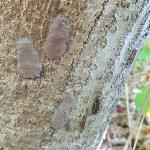 Spotted Lanternfly: (Lycorma delicatula, SLF) is a non-native, invasive insect that feeds on over 103 species of plants, including many trees and shrubs that are important in our landscapes. It overwinters as an egg mass, which the adult female insect lays on just about any flat surface. Pictures of egg masses can be seen at https://massnrc.org/pests/linkeddocuments/SLFChecklistForResidents.pdf
Spotted Lanternfly: (Lycorma delicatula, SLF) is a non-native, invasive insect that feeds on over 103 species of plants, including many trees and shrubs that are important in our landscapes. It overwinters as an egg mass, which the adult female insect lays on just about any flat surface. Pictures of egg masses can be seen at https://massnrc.org/pests/linkeddocuments/SLFChecklistForResidents.pdf
Spotted lanternfly egg masses have begun hatching as of this week in Springfield, MA! The MA Department of Agricultural Resources (MDAR) reports seeing spotted lanternfly nymphs hatching from and resting on their egg masses in areas of Springfield where a breeding population of this insect has become established. Some nymphs have already begun to migrate away from the locations where their egg masses are located. Egg hatch has not yet (at the time of publication) been observed in Fitchburg, Shrewsbury, or Worcester, MA but it is anticipated to begin very soon. UMass Extension thanks MDAR for sharing these reports!Currently, the only established populations of spotted lanternfly in Massachusetts are in Fitchburg, Shrewsbury, Worcester, and Springfield MA. Therefore, there is no reason to be preemptively treating for this insect in other areas of Massachusetts. If you suspect you have found spotted lanternfly in additional locations, please report it immediately to MDAR at https://massnrc.org/pests/slfreport.aspx. If you are living and working in the Fitchburg, Shrewsbury, Worcester, and Springfield, MA areas, please be vigilant and continue to report anything suspicious.
For More Information:
From UMass Extension:
*New*: Spotted Lanternfly Management Guide for Professionals
*Note that management may only be necessary in areas where this insect has become established in Massachusetts and if high value host plants are at risk. Preemptive management of the spotted lanternfly is not recommended.
Check out the InsectXaminer Episode about spotted lanternfly adults and egg masses!
From the MA Department of Agricultural Resources:
Fact Sheet and Map of Locations in MA
Spotted Lanternfly Management Guide for Homeowners in Infested Areas
*New*: Spotted Lanternfly Look-alikes in MA
*New*: Spotted Lanternfly Egg Mass Look-alikes
- Asian Longhorned Beetle: (Anoplophora glabripennis, ALB) Look for signs of an ALB infestation which include perfectly round exit holes (about the size of a dime), shallow oval or round scars in the bark where a female has chewed an egg site, or sawdust-like frass (excrement) on the ground nearby host trees or caught in between branches. Be advised that other, native insects may create perfectly round exit holes or sawdust-like frass, which can be confused with signs of ALB activity.
The regulated area for Asian longhorned beetle is 110 square miles encompassing Worcester, Shrewsbury, Boylston, West Boylston, and parts of Holden and Auburn. If you believe you have seen damage caused by this insect, such as exit holes or egg sites, on susceptible host trees like maple, please call the Asian Longhorned Beetle Eradication Program office in Worcester, MA at 508-852-8090 or toll free at 1-866-702-9938.
To report an Asian longhorned beetle find online or compare it to common insect look-alikes, visit: http://massnrc.org/pests/albreport.aspx or https://www.aphis.usda.gov/pests-diseases/alb/report.
- White Spotted Pine Sawyer (WSPS): Monochamus scutellatus adults can emerge in late May throughout July, depending on local temperatures. This is a native insect in Massachusetts and is usually not a pest. Larvae develop in weakened or recently dead conifers, particularly eastern white pine (Pinus strobus). However, the white spotted pine sawyer looks very similar to the invasive Asian Longhorned Beetle (ALB), Anoplophora glabripennis. ALB adults do not emerge in Massachusetts until July and August. Beginning in July, look for the key difference between WSPS and ALB adults, which is a white spot in the top center of the wing covers (the scutellum) on the back of the beetle. White spotted pine sawyer will have this white spot, whereas Asian longhorned beetle will not. Both insects can have other white spots on the rest of their wing covers; however, the difference in the color of the scutellum is a key characteristic. See the Asian longhorned beetle entry above for more information about that non-native insect.
 Emerald Ash Borer: (Agrilus planipennis, EAB) has been detected in at least 11 out of the 14 counties in Massachusetts. A map of these locations across the state may be found at https://ag.umass.edu/fact-sheets/emerald-ash-borer. Additional information about this insect is provided by the MA Department of Conservation and Recreation at https://storymaps.arcgis.com/stories/b60f63199fa14805a8b9f7c82447a25b.
Emerald Ash Borer: (Agrilus planipennis, EAB) has been detected in at least 11 out of the 14 counties in Massachusetts. A map of these locations across the state may be found at https://ag.umass.edu/fact-sheets/emerald-ash-borer. Additional information about this insect is provided by the MA Department of Conservation and Recreation at https://storymaps.arcgis.com/stories/b60f63199fa14805a8b9f7c82447a25b.
This wood-boring beetle readily attacks ash (Fraxinus spp.) including white, green, and black ash and has also been found developing in white fringe tree (Chionanthus virginicus) and has been reported in cultivated olive (Olea europaea). Signs of an EAB infested tree may include D-shaped exit holes in the bark (from adult emergence), “blonding” or lighter coloration of the ash bark from woodpecker feeding (chipping away of the bark as they search for larvae beneath), and serpentine galleries visible through splits in the bark from larval feeding beneath. It is interesting to note that woodpeckers are capable of eating 30-95% of the emerald ash borer larvae found in a single tree (Murphy et al. 2018). Unfortunately, despite high predation rates, EAB populations continue to grow. However, there is hope that biological control efforts will eventually catch up with the emerald ash borer population and preserve some of our native ash tree species for the future.
- Winter Moth (Operophtera brumata): Data since 2017 has indicated that the winter moth population in eastern Massachusetts has been on the decline while the percent of winter moth pupae parasitized by Cyzenis albicans has increased! Dr. Joseph Elkinton’s laboratory at UMass Amherst has released this biological control agent of winter moth since 2005 and conducted the rigorous sampling required to determine where the insect has established and what its impact on the winter moth population has been at multiple sites in eastern MA.
The take-home point? Do not worry about winter moth this spring! In fact, management of this insect in landscaped settings will likely not be necessary in most locations. Blueberry growers may still, on the other hand, be interested in scouting and continuing to monitor for this insect, as only very low numbers of winter moth caterpillars might be tolerated in that system. For blueberry and apple growers in Rhode Island, check out this winter moth update from Heather Faubert (University of Rhode Island) for April 13, 2023.
In recent years, it is worthwhile to note that some areas on the Cape and other locations in eastern MA have reported noticeable native cankerworm populations in the spring, which are often confused for winter moth. Read more about cankerworms in the list below.
Winter moth caterpillars will drop to the soil to pupate by late May/early June in Massachusetts. Once pupation occurs, management is no longer practical or necessary.
-
Jumping Worms: Amynthas spp. earthworms, collectively referred to as “jumping or crazy or snake” worms, overwinter as eggs in tiny, mustard-seed sized cocoons found in the soil or other substrate (ex. compost). Immature jumping worms hatch from their eggs by approximately mid-to-late May. It may be impossible to see them at first, and it may be more likely that jumping worms are noticed when the first adults begin to appear at the end of May and in June. It is easy to misidentify jumping worms (ex. mistake European earthworms for jumping worms) if only juveniles are found. In August and September, most jumping worms have matured into the adult life stage and identification of infestations is more likely to occur at that time of year.
For More Information:
UMass Extension Fact Sheets:
- Earthworms in Massachusetts – History, Concerns, and Benefits
- Jumping/Crazy/Snake Worms – Amynthas spp.
- A Summary of the Information Shared at UMass Extension’s Jumping Worm Conference in January 2022
- Invasive Jumping Worm Frequently Asked Questions (Over 70 Questions and their Answers)
Tree & Shrub Insect Pests(Native and Invasive):
- Andromeda Lace Bug: Stephanitis takeyai is most commonly encountered on Japanese andromeda. Eggs are tiny and inserted into the midveins on the lower surface of the leaf and covered with a coating that hardens into a protective covering. Five nymphal stages are reported. Nymphs are different in appearance from the adults, often covered with spiky protrusions. 3-4 generations per year have been observed in New England, with most activity seen between late-May into September (starting at approximately 120 GDD’s, base 50°F). Both nymphs and adults can be seen feeding on leaf undersides. Adults have delicate, lace-like wings and what appears to be an "inflated hood" that covers their head. Adults are approximately 1/8 inch long. Arrived in the US in Connecticut in 1945 from Japan (Johnson and Lyon, 1991).
Can cause severe injury to Japanese andromeda, especially those in full sun. Mountain andromeda (Pieris floribunda) is highly resistant to this pest. Like other lace bugs, this insect uses piercing-sucking mouthparts to drain plant fluids from the undersides of the leaves. Damage may be first noticed on the upper leaf surface, causing stippling and chlorosis (yellow or off-white coloration). Lace bug damage is distinguished from that of other insects upon inspecting the lower leaf surface for black shiny spots, "shed" skins from the insects, and adult and nymphal lace bugs themselves.
A first sign of potential lace bug infestation is stippling or yellow/white colored spots or chlorosis on host plant leaf surfaces. Lace bugs excrete a shiny, black, tar-like excrement that can often be found on the undersides of infested host plant leaves. Flip leaves over to inspect for this when lace bug damage is suspected.
Mountain andromeda (Pieris floribunda) is considered to be highly resistant to this insect and can be used as an alternative for such plantings along with other lace bug-resistant cultivars. Consider replacing Japanese andromeda with mountain andromeda as a way to manage for this pest. Natural enemies are usually predators and sometimes are not present in large enough numbers in landscapes to reduce lace bug populations. Structurally and (plant) species complex landscapes have been shown to reduce azalea lace bug populations through the increase of natural enemies.
- Arborvitae Leafminer: In New England and eastern Canada, four species of leafminers are known to infest arborvitae. These include Argyresthia thuiella, A. freyella, A. aureoargentella, and Coleotechnites thujaella. The arborvitae leafminer, A. thuiella, is the most abundant of these and has the greatest known range when compared to the others (it is also found in the Mid-Atlantic States and as far west as Missouri). Moths of this species appear from mid-June to mid-July and lay their eggs. The damage caused by all of these species is nearly identical. Trees, however, have been reported to lose up to 80% of their foliage due to arborvitae leafminer and still survive. At least 27 species of parasites have been reported as natural enemies of arborvitae leafminers, the most significant of which may be a parasitic wasp (Pentacnemus bucculatricis). Arborvitae leafminer damage causes the tips of shoots and foliage to turn yellow and brown. If infestations are light, prune out infested tips.
- Azalea Lace Bug: Stephanitis pyrioides is native to Japan. The azalea lace bug deposits tiny eggs on the midveins on leaf undersides. They then cover the area where the egg was inserted with a brownish material that hardens into a protective covering. Each female may lay up to 300 eggs (University of Florida). Nymphs hatch from the eggs and pass through 5 instars. The length of time this takes depends on temperature. Between 2 and 4 generations may be completed in a single year. In Maryland, there are four generations per year. Adults are approximately 1/10 inch long with lacy, cream colored, transparent wings held flat against the back of the insect. Wings also have black/brown patches. Adults of this species also possess a "hood" over their head. Nymphs are colorless upon hatching, but develop a black color as they mature and are covered in spiny protrusions.
Immatures and adults use piercing-sucking mouthparts to remove plant fluids from leaf tissues. This feeding leaves behind white-yellow stippling on the upper surface of host plant leaves, even though the insects themselves feed on the underside of the leaf. Plants in full sun are often particularly damaged by these insects. In heavy infestations, plants in full sun may be killed by the feeding of the azalea lace bug.
Begin scouting for azalea lace bugs when 120 GDD’s (base 50°F) are reached. This species is active throughout the summer. Look for dark, black, tar-like spots of excrement deposited by immature and adult lace bugs on the underside of susceptible host plant leaves, especially on leaves with white-yellow stippling visible on the upper surface. If lace bugs are not already known to the location, check susceptible hosts located in full sun first. Monitor plants for lace bug feeding from late April through the summer.
Plant azaleas in partial shade. Resistance has been reported in Rhododendron atlanticum, R. arborescens, R. canescens, R. periclymenoides, and R. prunifolium.
Many of the natural enemies reported for this insect are predators. They are rarely abundant enough to reduce damaging populations of lace bugs, especially on plants in sunny locations. Structurally and (plant) species complex landscapes have been shown to reduce azalea lace bug populations through the increase of natural enemies.
- Azalea Sawflies: There are a few species of sawflies that impact azaleas. Johnson and Lyon's Insects that Feed on Trees and Shrubs mentions three of them. Amauronematus azaleae was first reported in New Hampshire in 1895 and is likely found in most of New England. Adults of this species are black with some white markings and wasp-like. Generally, green larvae feed mostly on mollis hybrid azaleas. Remember, sawfly caterpillars have at least enough abdominal prolegs to spell “sawfly” (so 6 or more prolegs). Adults are present in May and females lay their eggs; larvae then hatch and feed through the end of June. There is one generation per year. Nematus lipovskyi has been reared from swamp azalea (Rhododendron viscosum). Adults of that species have been collected in April (in states to the south) and May (in New England) and larval feeding is predominantly in late April and May in Virginia and June in New England. One generation of this species occurs per year, and most mollis hybrid azaleas can be impacted. A third species, Arge clavicornis, is found as an adult in July and lays its eggs in leaf edges in rows. Larvae are present in August and September. Remember, Bacillus thuringiensis Kurstaki does not manage sawflies.
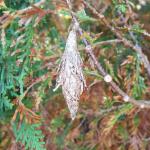 Bagworm:Thyridopteryx ephemeraeformis is a native species of moth whose larvae construct bag-like coverings over themselves with host plant leaves and twigs. This insect overwinters in the egg stage within the bags of deceased females from last season. Eggs may hatch and young larvae are observed feeding around mid-June, or roughly between 600-900 GDD’s. Now is the time to scout for and remove and destroy overwintered bags. In recent years, an increase in bagworm activity (particularly in urban forests) in Massachusetts has been noticed by professionals. Thus far in 2023, reports have been made from Plymouth County, MA. More information can be found here:https://ag.umass.edu/landscape/fact-sheets/bagworm
Bagworm:Thyridopteryx ephemeraeformis is a native species of moth whose larvae construct bag-like coverings over themselves with host plant leaves and twigs. This insect overwinters in the egg stage within the bags of deceased females from last season. Eggs may hatch and young larvae are observed feeding around mid-June, or roughly between 600-900 GDD’s. Now is the time to scout for and remove and destroy overwintered bags. In recent years, an increase in bagworm activity (particularly in urban forests) in Massachusetts has been noticed by professionals. Thus far in 2023, reports have been made from Plymouth County, MA. More information can be found here:https://ag.umass.edu/landscape/fact-sheets/bagworm- Boxwood Leafminer: Monarthropalpus flavus partly grown fly larvae overwinter in the leaves of susceptible boxwood. Yellowish mines may be noticeable on the undersides of leaves. This insect grows rapidly in the spring, transforming into an orange-colored pupa. After pupation, adults will emerge and white colored pupal cases may hang down from the underside of leaves where adults have emerged. Adults may be observed swarming hosts between 300-650 GDD’s, or roughly the end of May through June. Most cultivars of Buxus sempervirens and B. microphylla are thought to be susceptible. If installing new boxwoods this spring, resistant cultivars such as ‘Vardar Valley’ and ‘Handsworthiensis’ are good choices at sites where this insect has been a problem. For more information, visit: https://ag.umass.edu/landscape/fact-sheets/boxwood-leafminer.
- Boxwood Mite: Eurytetranychus buxi overwinter as tiny eggs on boxwood leaves and hatch mid-spring. These mites are tiny (about the size of a period) and difficult to detect. Feeding may cause plants to appear off-color. If management is deemed necessary, the timing for treatment may be between 245-600 GDD’s.
- Boxwood Psyllid: Psylla buxi feeding can cause cupping of susceptible boxwood leaves. Leaf symptoms/damage may remain on plants for up to two years. English boxwood may be less severely impacted by this pest. Eggs overwinter, buried in budscales, and hatch around budbreak of boxwood. Eggs may hatch around 80 GDD’s. While foliar applications may be made between 290-440 GDD’s, the damage caused by this insect is mostly aesthetic. Therefore, typically, management is not necessary. For more information, visit: https://ag.umass.edu/landscape/fact-sheets/boxwood-psyllid.
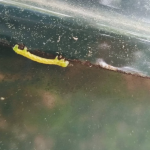 Cankerworms: Alsophila pometaria (fall cankerworm) and Paleacrita vernata (spring cankerworm) are often confused for winter moth (Operophtera brumata). Cankerworm populations in eastern MA, particularly on areas of Cape Cod, were confused for winter moth in 2019. Spring cankerworm adults are active in February and March, and fall cankerworm adults are active in late November into early December. During these times, both species lay eggs. These native insects most commonly utilize elm, apple, oak, linden, and beech. Eggs of both species hatch as soon as buds begin to open in the spring. Caterpillars occur in mixed populations and are often noticeable by mid-May in MA. Young larvae feed on buds and unfolding leaves. There are two color forms (light green and dark) for caterpillars of both species. Fall cankerworm was reported from Barnstable County on 5/24/2023. See photo above from Tamar Haspel who shares that the fall cankerworm caterpillars in the forest near them are so abundant that “if you put them together end to end you would get to the moon”. Like winter moth, they drop to the soil to pupate. This usually occurs in June. Fall cankerworm larvae have three pairs of prolegs (one of which is small so it is sometimes referred to as ½) and spring cankerworm have two pairs (winter moth caterpillars also have 2 pairs of prolegs). If populations are large and damage is noticeable on hosts, reduced risk insecticides such as Bacillus thuringiensis Kurstaki or spinosad may target larvae between approximately 148-290 GDD’s. For more information, visit: https://ag.umass.edu/landscape/fact-sheets/fall-cankerworm.
Cankerworms: Alsophila pometaria (fall cankerworm) and Paleacrita vernata (spring cankerworm) are often confused for winter moth (Operophtera brumata). Cankerworm populations in eastern MA, particularly on areas of Cape Cod, were confused for winter moth in 2019. Spring cankerworm adults are active in February and March, and fall cankerworm adults are active in late November into early December. During these times, both species lay eggs. These native insects most commonly utilize elm, apple, oak, linden, and beech. Eggs of both species hatch as soon as buds begin to open in the spring. Caterpillars occur in mixed populations and are often noticeable by mid-May in MA. Young larvae feed on buds and unfolding leaves. There are two color forms (light green and dark) for caterpillars of both species. Fall cankerworm was reported from Barnstable County on 5/24/2023. See photo above from Tamar Haspel who shares that the fall cankerworm caterpillars in the forest near them are so abundant that “if you put them together end to end you would get to the moon”. Like winter moth, they drop to the soil to pupate. This usually occurs in June. Fall cankerworm larvae have three pairs of prolegs (one of which is small so it is sometimes referred to as ½) and spring cankerworm have two pairs (winter moth caterpillars also have 2 pairs of prolegs). If populations are large and damage is noticeable on hosts, reduced risk insecticides such as Bacillus thuringiensis Kurstaki or spinosad may target larvae between approximately 148-290 GDD’s. For more information, visit: https://ag.umass.edu/landscape/fact-sheets/fall-cankerworm.-
Dogwood Borer: Synanthedon scitula is a species of clearwing moth whose larvae bore not only into dogwood (Cornus), but hosts also include flowering cherry, chestnut, apple, mountain ash, hickory, pecan, willow, birch, bayberry, oak, hazel, myrtle, and others. Kousa dogwood appear to be resistant to this species. Signs include the sloughing of loose bark, brown frass, particularly near bark cracks and wounds, dead branches, and adventitious growth. The timing of adult emergence can be expected when dogwood flower petals are dropping and weigela begins to bloom. Adult moth flights continue from then until September. Emergence in some hosts (ex. apple) appears to be delayed, but this differs depending upon the location in this insect’s range. Eggs are laid singly or in small groups, on smooth and rough bark. Female moths preferentially lay eggs near wounded bark. After hatch, larvae wander until they find a suitable entrance point into the bark. This includes wounds, scars, or branch crotches. This insect may also be found in twig galls caused by other insects or fungi. Larvae feed on phloem and cambium. Fully grown larvae are white with a light brown head and approx. ½ inch long. Pheromone traps and lures are useful for determining the timing of adult moth emergence and subsequent management.
-
Dogwood Sawfly: Macremphytus tarsatus has one generation per year. The larvae of the dogwood sawfly overwinter in decaying wood and occasionally compromised structural timber. An overwintering "cell" is created in this soft wood. Pupation occurs in the springtime and adults can take a lengthy time to emerge, roughly between late May and July. 100+ eggs are laid in groups on the underside of leaves. Eggs hatch and the larvae feed gregariously, initially skeletonizing leaves. Foliage of dogwood, especially gray dogwood (Cornus racemosa), may be impacted. As the caterpillars grow in size, they are capable of eating the entire leaf with the exception of the midvein. Larval appearance varies greatly throughout instars, so much so that one might mistake them for multiple species. Early instars are translucent and yellow, but as the caterpillars grow they develop black spots (over yellow) and become covered in a white powder-like material. Larvae and their shed skins may resemble bird droppings. Full grown larvae begin to wander in search of a suitable overwintering location. Rotting wood lying on the ground is preferred for this.
- Eastern Tent Caterpillar: Malacosoma americanum eggs overwinter on host plant twigs. Egg hatch typically occurs when wild cherry leaves begin to unfold and young caterpillars may emerge by late-April through the first two weeks in May (90-190 GDD’s). Susceptible hosts include cherry and crabapple. Other host plants whose leaves are fed upon by this native insect can include apple, ash, birch, willow, maple, oak, poplar, and witch-hazel. Where practical, prune out and remove new eastern tent caterpillar tents before they become larger as the caterpillars continue to feed. Eastern tent caterpillars are native to Massachusetts and have many associated natural enemies (parasites and predators) that help regulate populations. Unless these caterpillars are actively defoliating specimen trees in a landscaped setting, we can coexist with this particular herbivore native to our forests.
- Elongate Hemlock Scale: Fiorinia externa is found on eastern, Carolina, and Japanese hemlock, as well as yew, spruce, and fir. The elongate hemlock scale may overwinter in various life stages, and overlap of many developmental stages at any given time can be observed throughout much of the season. Treatments for the crawler, or mobile, stage of this insect may be made in late May through mid-June, or between 360-700 GDD’s (base 50°F). Nitrogen fertilizer applications may make elongate hemlock scale infestations worse. For more information, visit: https://ag.umass.edu/landscape/fact-sheets/elongate-hemlock-scale.
- Elm Leaf Beetle: Xanthogaleruca (formerly Pyrrhalta) luteola is found on American elm (Ulmus americana; not preferred), Chinese Elm (Ulmus parvifolia; not preferred), English Elm (Ulmus procera; preferred host), Japanese Zelkova (Zelkova serrata), and Siberian Elm (Ulmus pumila; preferred host). This species was accidentally introduced into the eastern United States early in the 1800's. Since then, it has been found throughout the US anywhere elms are located. It also occurs in eastern Canada. The adult elm leaf beetle overwinters in protected areas, such as the loose bark of trees, but can also be a nuisance when it tries to invade homes in search of overwintering protection. Beetles will try to enter houses or sheds in the fall.
In the spring, the adult beetles fly back to the host plant and chew small, semi-circular holes in the leaves. The adult female can lay 600-800 yellow eggs in her life. Eggs are laid in clusters on the leaves and resemble pointy footballs. Larvae are tiny, black, and grub-like when they hatch from the egg. Feeding by young larvae skeletonizes the undersides of leaves. As they grow in size, the larvae become yellow-green with rows of black projections. Oldest larvae may appear to have two black stripes along their sides, made from the black projections. There are 3 larval instars. Mature larvae will wander down the trunk of the host tree and pupate in the open on the ground at the tree base or in cracks and crevices in the trunk or larger limbs. They spend approximately 10 or so days as a pupa before the adults emerge. These adults fly to the foliage of the same host plant or other adjacent potential hosts in the area, where they lay eggs. In the fall, the adults leave the host plant in search of overwintering shelter. In most locations in the US, two generations of this insect are possible per year. In warmer locations, 3-4 generations per year are possible.
Leaves are skeletonized by the larvae, which may cause the leaf to turn brown or whitish. Adults are capable of chewing through the leaf, often in a shothole pattern. When in very large populations, they are capable of completely defoliating plants. Populations of this insect can fluctuate from year to year, and often management is not necessary if populations are low. However, defoliation for consecutive seasons may lead to branch dieback or death of the entire tree.
- Euonymus Caterpillar: Yponomeuta cagnagella is of European origin and is widespread throughout Europe. It was first reported in North America in Ontario in 1967. The euonymus caterpillars (larvae) feed in groups and envelop the foliage of the host plant in webs as they feed. Hosts include: Euonymus europaeus (tree form), E. kiautschovicus, E. alatus, and E. japonicus. Mature caterpillars are just under an inch in length, creamy yellow-gray in color with black spots and a black head capsule. By late June, these larvae pupate in white, oval-shaped cocoons which are typically oriented together vertically either on host plants or non-hosts in the area. Cocoons can be found in cracks and crevices, or webbed together leaves. The adult moth emerges in late June in most locations. The adult female secretes a gummy substance over her eggs which hardens, making them even more difficult to see. Eggs hatch by mid-August, at which time the tiny larvae prepare to overwinter beneath their eggshell-like covering. These larvae are inactive until the following year, when caterpillars group together to feed on newly emerging leaves, creating a mess of webs as they feed. There is one generation per year. Plants may be partially or entirely defoliated. Management of young, actively feeding caterpillars with Bacillus thuringiensis is possible if deemed necessary; however, many species of Euonymus are considered invasive themselves. Check out Episode 3 of InsectXaminer to see the euonymus caterpillar in action and learn more about its life cycle.
- Euonymus Scale: Unaspis euonymi is an armored scale that can be found on euonymus, holly, bittersweet, and pachysandra. This insect can cause yellow spotting on leaves, dieback, and distorted bark. For crawlers, early June timing is suggested between 533-820 GDD’s for management (eggs begin to hatch in early June).
- Fletcher Scale: Parthenolecanium fletcheri is a soft scale pest of yew, juniper, and arborvitae. Feeding scales, especially on yew, result in honeydew and sooty mold, needle yellowing, and at times, premature needle drop. There is one generation per year. Overwintered second instar nymphs can be targeted between 38-148 GDD's (base 50°F). Nymphs develop and adult females lay eggs (on average 500-600 GDD) in May that hatch by June. Dead females conceal egg masses beneath. Crawlers migrate short distances to branches and may be concentrated on certain branches of a particular plant.
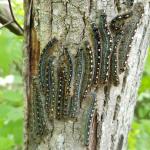 Forest Tent Caterpillar: Malacosoma disstria egg hatch occurs between 192-363 GDD’s (base 50°F) by mid-late May and caterpillars may be active for at least 5-6 weeks following. Susceptible hosts whose leaves are fed on by this insect include oak, birch, ash, maple, elm, poplar, and basswood. This native insect has many natural enemies, including some very effective pathogens that typically regulate populations. However, outbreaks of this insect can occur on occasion.
Forest Tent Caterpillar: Malacosoma disstria egg hatch occurs between 192-363 GDD’s (base 50°F) by mid-late May and caterpillars may be active for at least 5-6 weeks following. Susceptible hosts whose leaves are fed on by this insect include oak, birch, ash, maple, elm, poplar, and basswood. This native insect has many natural enemies, including some very effective pathogens that typically regulate populations. However, outbreaks of this insect can occur on occasion.- Hemlock Looper: Two species of geometrid moths in the genus Lambdina are native insects capable of defoliating eastern hemlock, balsam fir, and white spruce. Adult moths lay their eggs on the trunk and limbs of hosts in September and October, and eggs hatch by late May or early June (L. fiscellaria caterpillars may be active between 448-707 GDD’s). Monitor susceptible hosts for small, inch-worm like caterpillars. Where populations are low, no management is necessary. Hemlock loopers have several effective natural enemies.
- Holly Leafminers: Seven species of leaf miners feed on holly. Phytomyza ilicicola is usually referred to as the native holly leafminer. This species is known to feed on Ilex opaca, I. crenata, and related cultivars; however, it only lays its eggs in American holly (Ilex opaca). Some research suggests that the native holly leafminer may lay its eggs in other Ilex species, but that the larvae are unable to complete their development. This insect is found throughout the native range of its host plants. Larvae overwinter in leaf mines and pupation occurs in March and April, with adult emergence by mid-May (192-298 GDD’s, base 50°F). Adult flies are known to emerge over a period of 6 or so weeks in the spring. Females lay eggs using their ovipositor on the underside of newly formed leaves. A tiny green blister forms on the leaf as the first symptom of injury. Larvae hatch from the egg and create a narrow mine that may appear brown from the upper leaf surface. Mines are broadened in the fall and a large blotch is completed in the winter. Larvae are yellow maggots and reach 1.5 mm (.06 inches) in length when mature. Current year’s mines are easily overlooked due to the slow feeding patterns of the larvae. Premature leaf drop may occur. Remove and destroy mined leaves before May. Phytomyza ilicis is usually only referred to as the holly leafminer; it is a non-native species introduced from Europe and only feeds on Ilex aquifolium (the native holly leafminer does not develop in I. aquifolium). The biology and damage this insect causes is similar to that of the native holly leafminer, with the exception of the fact that eggs are laid in the midvein of the leaf and young larvae tunnel in the vein until the fall. Remove and destroy mined leaves before May. Adults may be present mid-late May (246-448 GDD’s, base 50°F).
- Honeylocust Plant Bug: Diaphnocoris chlorionis feeding results in tiny yellowish-brownish spots on leaves, leaf distortion, and in some cases, defoliation. (There are at least 7 species of plant bugs that feed on honeylocust, Gleditsia triacanthos.) There is one generation per year. Immatures and adults feed on foliage and light to moderately damaged foliage may persist throughout the growing season. Honeylocust plant bugs overwinter as eggs laid just beneath the bark surface of 2 and 3 year old twigs. Eggs hatch just after vegetative buds of the host begin to open. Young nymphs crawl to the opening leaflets and begin feeding; the most significant damage occurs at that time, when the insect is hidden from view. Nymphs develop into adults around May-July. This insect can be targeted between 58-246 GDD’s (base 50°F).
- Hydrangea Leaftier: Olethreutes ferriferana is a moth in the Family Tortricidae whose caterpillars use silk applied to the edges of two newly expanding hydrangea leaves to tie them together to create an envelope-like structure within which they feed. These leaf-envelopes tend to occur near the tips of plant stems and can be very obvious. As a result, the two tied leaves may not fully expand when compared to healthy, non-impacted leaves. Many envelope or purse-like structures can be seen throughout the plants and may be found from the base to the top of the plant. By gently pulling apart the tied-together leaves, tiny caterpillars are revealed within and can be mechanically managed by crushing the individual caterpillars. Caterpillars are green and partially transparent with a black head capsule and a black thoracic shield which is found on the top of the body segment located directly behind the head. Pupation is thought to occur in the ground near by host plants, so the insect drops to the ground to pupate where it overwinters. Pupation occurs sometime in June. Adults are found in the spring and are small white and brown moths. Eggs are laid on branch tips of various species of hydrangea. Only one generation is known per year. This insect, although creating visible and interesting damage to hydrangea, is not usually considered to be a serious pest, although occasional localized problematic populations have been reported. Removing leaf-envelopes in the early spring or pinching them to kill the caterpillar within can help reduce populations on individual plants.
 Imported Willow Leaf Beetle: Plagiodera versicolora adult beetles overwinter near susceptible hosts. Adult beetles chew holes and notches in the leaves of willow once they become available. Females lay yellow eggs in clusters on the undersides of leaves. Larvae are slug-like and bluish-green in color. They feed in clusters and skeletonize the leaves. Most plants can tolerate the feeding from this insect, and foliage will appear brown. Repeated yearly feeding can be an issue, in which case management of the young larvae may be necessary. Take care with treatment in areas near water. Check out Episode 4 of InsectXaminer to see the imported willow leaf beetle in action.
Imported Willow Leaf Beetle: Plagiodera versicolora adult beetles overwinter near susceptible hosts. Adult beetles chew holes and notches in the leaves of willow once they become available. Females lay yellow eggs in clusters on the undersides of leaves. Larvae are slug-like and bluish-green in color. They feed in clusters and skeletonize the leaves. Most plants can tolerate the feeding from this insect, and foliage will appear brown. Repeated yearly feeding can be an issue, in which case management of the young larvae may be necessary. Take care with treatment in areas near water. Check out Episode 4 of InsectXaminer to see the imported willow leaf beetle in action.- Lecanium Scales (Oak): Parthenolecanium quercifex overwinters as a second instar nymph on oak twigs. Females begin feeding and mature in the spring from mid-April to early May; eggs may be laid between late May and into June. Eggs hatch in June or early July and crawlers migrate to host plant leaves where they spend the summer and migrate as second instars back to host plant twigs in the fall.
- Lilac Borer: Podosesia syringae is a clearwing moth pest of lilac, privet, fringetree, and ash. (It is also known as the ash borer, not to be confused with the emerald ash borer.) Adults mimic paper wasps. Larvae are wood-boring, and signs and symptoms include branch dieback, holes, and occasionally, sawdust-like frass accumulated on bark. Larvae bore into stems, trunks, and branches, chewing an irregularly shaped entrance hole. Peak adult moth flights may occur in the northern portion of this insect’s range in June and is usually over by August 1st. Pheromone traps can be used to time adult emergence. Adult females lay flattened, oval, and tan eggs that are deposited singly or in clusters on bark crevices, ridges, and sometimes smooth bark; but usually laid in or near wounds in the bark. On average, 395 eggs are laid by each female. After hatch, larvae chew into the bark and feed laterally and then vertically in phloem tissue. Larvae overwinter in tunnels in the final instar and resume feeding in the spring. Adults emerge through a round exit hole (4-5 mm in diameter). This insect may be targeted between 200-299 GDD’s (base 50°F).
 Lily Leaf Beetle: Lilioceris liliiadults overwinter in sheltered places. As soon as susceptible hosts such as Lilium spp. (Turk’s cap, tiger, Easter, Asiatic, and Oriental lilies) and Fritillaria spp. break through the ground, the adult lily leaf beetles are known to feed on the new foliage. (Note: daylilies are not hosts.) Adult lily leaf beetles were observed to be active in Hanson, MA on 4/14/2023. Typically, mating occurs in May and each female begins to lay 250-450 eggs in neat rows on the underside of the foliage. If there are only a few plants in the garden, hand picking and destroying overwintering adults can help reduce local garden-level populations at that time. Check out Episode 3 of InsectXaminer to see the lily leaf beetle in action.
Lily Leaf Beetle: Lilioceris liliiadults overwinter in sheltered places. As soon as susceptible hosts such as Lilium spp. (Turk’s cap, tiger, Easter, Asiatic, and Oriental lilies) and Fritillaria spp. break through the ground, the adult lily leaf beetles are known to feed on the new foliage. (Note: daylilies are not hosts.) Adult lily leaf beetles were observed to be active in Hanson, MA on 4/14/2023. Typically, mating occurs in May and each female begins to lay 250-450 eggs in neat rows on the underside of the foliage. If there are only a few plants in the garden, hand picking and destroying overwintering adults can help reduce local garden-level populations at that time. Check out Episode 3 of InsectXaminer to see the lily leaf beetle in action.- Magnolia Scale: Neolecanium cornuparvum overwinters as first instar nymphs which are elliptical, dark slate gray in color, and can usually be found on the undersides of 1 and 2 year old twigs. Nymphs may molt by late April or May and again by early June, at which time the scales may be purple in color. Eventually nymphs secrete a white powdery layer of wax over their bodies. For more information, visit: https://ag.umass.edu/landscape/fact-sheets/magnolia-scale.
- Oak Apple Galls: Several species of gall wasps cause structures referred to as oak apple galls. A common species mentioned in Johnson and Lyon (1991) is Amphibolips confluenta, which forms large galls that are attached to the midrib or petiole of oak leaves. Additional species in this genus are known to cause oak apple galls, including A. quercusinanis and A. quercusspongifica. A. confluenta galls are filled with a spongy mass that may be cut with a knife. A single wasp larva is found within a hard, seed-like cell in the center of the gall. As the gall dries, the spongy interior becomes a mass of fibers radiating from this central cell to the thin shell of the gall. These galls do no damage to their host plants and do not require management. Not enough is known about gall forming insects, and there is so much to learn!
-
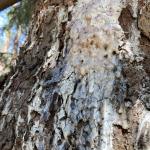 Pitch Mass Borer: Synanthedon pini is a native clearwing moth whose larvae feed within various pines and spruce. Feeding by the larvae (caterpillars) of this insect causes pitch masses to form on host plants. Two or three years are required for this insect to complete its life cycle, with adult moths present during the summer. Adult pitch mass borer moths may resemble wasps. Adult males and females are blue/black from above, marked with a patch of red/orange on the underside of the abdomen, with some orange on the top of the fourth abdominal segment. Orange is also found along the sides of the abdomen. Forewings are black/blue in color and opaque with wing length of 0.47 to 0.59 inches. Adults are said to emerge, mate, and females lay eggs on their hosts sometime in July. By the late summer, the larvae (immatures; caterpillars) bore into their host plant, tunneling through the trunks, often directly beneath a branch. Larvae have uniformly dark brown heads, white bodies, and prolegs with rows of 6-8 crochets on the bottom of their "feet". At the site of the borer wound, large amounts of pitch exude from the tree in a hemispherical mass above the larval tunnels. Larvae continue to feed and develop in the tree through the following year and it is thought that these caterpillars may take up to two years to mature. Masses may be 3-4 inches in diameter. Pupation occurs in a subsequent end of May through June in time for adult emergence by July and August. Pupal cells are formed within the pitch mass and lined with silk (Beuttenmüller, 1901). Pupae are 3/4 inch long and light brown in color (Kellicott, 1881).
Pitch Mass Borer: Synanthedon pini is a native clearwing moth whose larvae feed within various pines and spruce. Feeding by the larvae (caterpillars) of this insect causes pitch masses to form on host plants. Two or three years are required for this insect to complete its life cycle, with adult moths present during the summer. Adult pitch mass borer moths may resemble wasps. Adult males and females are blue/black from above, marked with a patch of red/orange on the underside of the abdomen, with some orange on the top of the fourth abdominal segment. Orange is also found along the sides of the abdomen. Forewings are black/blue in color and opaque with wing length of 0.47 to 0.59 inches. Adults are said to emerge, mate, and females lay eggs on their hosts sometime in July. By the late summer, the larvae (immatures; caterpillars) bore into their host plant, tunneling through the trunks, often directly beneath a branch. Larvae have uniformly dark brown heads, white bodies, and prolegs with rows of 6-8 crochets on the bottom of their "feet". At the site of the borer wound, large amounts of pitch exude from the tree in a hemispherical mass above the larval tunnels. Larvae continue to feed and develop in the tree through the following year and it is thought that these caterpillars may take up to two years to mature. Masses may be 3-4 inches in diameter. Pupation occurs in a subsequent end of May through June in time for adult emergence by July and August. Pupal cells are formed within the pitch mass and lined with silk (Beuttenmüller, 1901). Pupae are 3/4 inch long and light brown in color (Kellicott, 1881).Adult moths are active during the summer. Following egg laying and egg hatch, the larvae tunnel under the bark to the cambium. Obvious large globs of pitch appear on trunks. Occurs sporadically on individual trees. Host trees with active caterpillars have pitch masses that may appear coated in a white, powdery substance. Larvae may also preferentially bore into the host beneath a broken branch or scar. This insect will attack large trees, up to 30-40 feet from the ground. Healthy trees are also preferentially utilized. Overall damage to the health of the host tree is typically not extensive, and therefore chemical management of this insect is often unnecessary.
Pitch can be removed and the single larva within destroyed. Physical/mechanical management of this insect, if it can be safely done, is a great way to manage the pitch mass borer on individual specimen trees. The act of just pulling the caterpillar from its pitch mass will kill it - much to the frustration of history's entomologists looking to study them - as soon as contact of the pitch is made with the caterpillar's body and hardens and adheres to them. Parasitism by natural enemies is reported to be relatively common. Parasitic wasps in the family Eulophidae are noted but not specified, as well as a caterpillar-eating species of fly (Engelhardt, 1946).
- Rhododendron Borer: Synanthedon rhododendri is one of the smallest of the native clearwing moths. Rhododendrons are preferred hosts, although mountain laurel and deciduous azaleas can be heavily infested, especially if they are planted in close proximity to rhododendrons. Injury may be first noticed in the fall (leaves lose their sheen, then become pale green, then olive, then chlorotic) and can look similar to drought stress. On branches that seem to be stunted, look at limb crotches, scars, and other irregularities for sawdust stuck on bark or on the ground beneath these areas. In late May and early June, holes may contain pupal shed skins extending halfway out. Moth emergence occurs in the late-spring, early-summer. After mating, female moths seek out suitable egg laying locations (preferring wounded areas or limb crotches). The female lays her eggs and dies. Eggs hatch and larvae tunnel into the inner bark where they feed in tunnels that become packed with reddish frass pellets. By late fall, larvae move to the sapwood where they overwinter and resume feeding by mid-March. Pupation occurs in the spring and there is one generation per year. Prune out and destroy infested branches before late May/June. Monitor for adults in mid-May (192-298 GDD’s, base 50°F).
-
Roseslugs: Two species of sawfly can be found on the leaves of roses at this time. These small, caterpillar-like larvae skeletonize the upper leaf surface and leave a “window-pane” like pattern behind. When present in large numbers, these insects are capable of defoliating their entire host. Caterpillars may feed until roughly mid-June, at which time they pupate. Management options include an insecticidal soap spray or a product containing spinosad.
- Snowball Aphid: Neoceruraphis viburnicola eggs overwinter on viburnum twigs and buds. Eggs hatch and this aphid becomes active on certain species of viburnum roughly between 148-298 GDD’s or around redbud bloom. This insect is particularly noticeable on V. opulus, V. prunifolium, and V. acerifolia. Stem mothers, appearing blueish-white, can be found in curled up and distorted foliage. Damage caused by this insect pest is mostly aesthetic.
- Spruce Bud Scale: Physokermes piceae is a pest of Alberta and Norway spruce, among others. Immatures overwinter on the undersides of spruce needles, dormant until late March. Immatures overwinter on the undersides of spruce needles, remaining dormant until late March. By April, females may move to twigs to complete the rest of their development. Mature scales are reddish brown, globular, 1/10 inch in diameter, and found in clusters of 3-8 at the base of new twig growth. They closely resemble buds and are often overlooked. Crawlers are present around June.
- Spruce Spider Mite: Oligonychus ununguisis a cool-season mite that becomes active in the spring from tiny eggs that have overwintered on host plants. Hosts include spruce, arborvitae, juniper, hemlock, pine, Douglas-fir, and occasionally other conifers. This particular species becomes active in the spring and can feed, develop, and reproduce through roughly June. When hot, dry summer conditions begin, this spider mite will enter a summer-time dormant period (aestivation) until cooler temperatures return in the fall. This particular mite may prefer older needles to newer ones for food. Magnification is required to view spruce spider mite eggs. Tapping host plant branches over white paper may be a useful tool when scouting for spider mite presence (view with a hand lens). Spider mite damage may appear on host plant needles as yellow stippling and occasionally fine silk webbing is visible.
- Taxus Mealybug: Dysmicoccus wistariae produces honeydew which leads to sooty mold growth, yellowing of needles, and sparsely foliated plants. Eventual dieback may be possible. This species is commonly associated with Taxus in New England, but can be occasionally found on dogwood, rhododendron, Prunus spp., maple, andromeda, and crabapple. These mealybugs are found on stems and branches and particularly like to congregate at branch crotches. Taxus mealybug feeds in the inner bark tissue of the trunk and branches. Adult females are present from June to August and give birth to living young in the summer. Immatures overwinter. A single generation may occur per year in New England, but areas to the south can have multiple generations of this insect. Management may be targeted between 246-618 GDD’s (base 50°F). Horticultural oil and neem oil may be used.
- Viburnum Leaf Beetle: Pyrrhalta viburni is a beetle in the family Chrysomelidae that is native to Europe, but was found in Massachusetts in 2004. By 2008, viburnum leaf beetle was considered to be present in all of Massachusetts. Larvae are present and feeding on plants from approximately late April to early May until they pupate sometime in June. Adult beetles emerge from pupation by approximately mid-July and also feed on host plant leaves, mate, and lay eggs at the ends of host plant twigs where they overwinter. This beetle feeds exclusively on many different species of viburnum, which includes, but is not limited to, susceptible plants such as V. dentatum, V. nudum, V. opulus, V. propinquum, and V. rafinesquianum. Some viburnum have been observed to have varying levels of resistance to this insect, including but not limited to V. bodnantense, V. carlesii, V. davidii, V. plicatum, V. rhytidophyllum, V. setigerum, and V. sieboldii. More information about viburnum leaf beetle may be found at http://www.hort.cornell.edu/vlb/ and at https://ag.umass.edu/landscape/fact-sheets/viburnum-leaf-beetle.
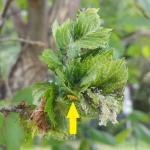 Woolly Apple Aphid: Eriosoma lanigerum may be found on apple, crabapple, hawthorn, mountain ash, Pyracantha, and elm hosts. The primary (winter) host is elm, on which aphids infest emerging spring leaves, causing leaves to curl or close into stunted, rosette-like clusters found at twig tips. On apple and crabapple, this species of aphid colonizes roots, trunks, and branches in the summer and is commonly found near previous wounds or callous tissue. On roots, the aphids cause swelled areas which can girdle and kill roots. The aphids, when found in above ground plant parts such as elm leaves, are covered with white wax. Eggs are the overwintering stage on elm, which hatch in the spring in time for the nymphs to infest new elm foliage. Following a few generations on elm, the aphids will develop into a winged form, which disperse and seek out apple and crabapple. Multiple generations will occur on these alternate hosts in the summer and by the fall, a winged form will return to elm and mated females lay eggs near elm buds. These aphids are a favorite snack for insect predators such as the multicolored Asian lady beetle, Harmonia axyridis.
Woolly Apple Aphid: Eriosoma lanigerum may be found on apple, crabapple, hawthorn, mountain ash, Pyracantha, and elm hosts. The primary (winter) host is elm, on which aphids infest emerging spring leaves, causing leaves to curl or close into stunted, rosette-like clusters found at twig tips. On apple and crabapple, this species of aphid colonizes roots, trunks, and branches in the summer and is commonly found near previous wounds or callous tissue. On roots, the aphids cause swelled areas which can girdle and kill roots. The aphids, when found in above ground plant parts such as elm leaves, are covered with white wax. Eggs are the overwintering stage on elm, which hatch in the spring in time for the nymphs to infest new elm foliage. Following a few generations on elm, the aphids will develop into a winged form, which disperse and seek out apple and crabapple. Multiple generations will occur on these alternate hosts in the summer and by the fall, a winged form will return to elm and mated females lay eggs near elm buds. These aphids are a favorite snack for insect predators such as the multicolored Asian lady beetle, Harmonia axyridis.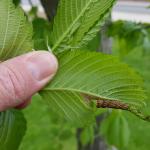 Woolly Elm Aphid: Eriosoma americanum females lay a single egg in the cracks and crevices of elm bark, where the egg overwinters. Eggs hatch on elm in the spring as leaves are unfolding. Aphids may be active from 121-246 GDD’s (base 50°F) on elm. A young, wingless female hatched from the egg feeds on the underside of leaf tissue. This female aphid matures and gives birth to 200 young, all females, without mating. These aphids feed and the elm leaf curls around them and protects them. By the end of June, winged migrants mature and find serviceberry hosts, where another set of females is produced. These new females crawl to and begin feeding on the roots of serviceberry. Multiple generations occur on the roots of serviceberry through the summer.
Woolly Elm Aphid: Eriosoma americanum females lay a single egg in the cracks and crevices of elm bark, where the egg overwinters. Eggs hatch on elm in the spring as leaves are unfolding. Aphids may be active from 121-246 GDD’s (base 50°F) on elm. A young, wingless female hatched from the egg feeds on the underside of leaf tissue. This female aphid matures and gives birth to 200 young, all females, without mating. These aphids feed and the elm leaf curls around them and protects them. By the end of June, winged migrants mature and find serviceberry hosts, where another set of females is produced. These new females crawl to and begin feeding on the roots of serviceberry. Multiple generations occur on the roots of serviceberry through the summer.
Concerned that you may have found an invasive insect or suspicious damage caused by one? Need to report a pest sighting? If so, please visit the Massachusetts Introduced Pests Outreach Project: http://massnrc.org/pests/pestreports.htm.
Reported by Tawny Simisky, Extension Entomologist, UMass Extension Landscape, Nursery, & Urban Forestry Program
Landscape Weeds
For identification of weed species noted below, refer to UMass Extension's Weed Herbarium: https://ag.umass.edu/weedid
Do not delay, treat garlic mustard, Alliaria petiolata, now. Second year plants are in full flower with seed pods visible. Garlic mustard is a biennial and herbicide applications at this time of year will control second-year plants before they go to seed as well as the first-year seedlings.
Many landscape trees commonly produce vegetative suckers at the base of the trunk. Suckers are commonly seen on crabapple, flowering cherry, flowering pear, plum, linden, maple, and sometimes oak. Honeylocust commonly produces vegetative sprouts along the entire length of the trunk. If these suckers or sprouts are not controlled, the landscape will be a contender for the “Shabby Landscape Award”. Pruning is effective but very time consuming. Another option would be to use pelargonic acid (ScytheTM) to remove these vegetative suckers and sprouts when they are very small. Very small means less than one inch in length or smaller. Pelargonic acid is a contact herbicide. If it is applied to small suckers and sprouts, the product will desiccate them and physical removal will not be required. Larger growth will first need to be physically removed and then pelargonic acid can be used as a maintenance program. Products that contain glyphosate should not be used as glyphosate is a translocated herbicide and injury to the tree is possible.
Scout for weeds that may be creeping into landscape beds from adjacent turf areas. Use a non-selective herbicide to edge the bed.
Inspect areas of the landscape where new trees or shrubs, especially those that were field grown, had been planted in the last year. Look for perennial weeds that may be growing from the root ball. Canada thistle, mugwort, quackgrass, bindweed and horsenettle are some of the possible culprits. Perennial weeds can be spot treated with glyphosate-based products.
Tree seedlings are continuing to germinate in landscape beds and some locations may have seedlings that are 2 to 3 inches tall. These seedlings can be treated with pelargonic acid (ScytheTM). Another option would be to cut these seedlings with a gas powered, electric, or battery powered hedge shear at the soil or mulch surface. Organic/non-chemical products do not translocate and so will not provide effective control of these young tree seedlings. Tree seedlings in turf areas will be controlled with mowing and an herbicide application is not necessary.
You may have noticed that a recent unseasonably, cold night resulted in frost damage to Japanese knotweed, Polygonum cuspidatum or Fallopia japonica. Frost injury was more common in low lying areas and was most apparent on the upper half of this season's new growth. Avoid the temptation to think that this will be the end of that population of knotweed, as this was just a tiny bump in the road for knotweed and new shoots have already started to push up. Do not attempt to control Japanese knotweed now, as herbicide applications are not effective when applied in the early part of the growing season. In preparation for a late season herbicide application, cut or mow stands of knotweed to the ground in late May and early June. This practice is done to facilitate herbicide application by removing the dried stems from the previous year’s growth and will control plant height so the knotweed will be shorter at time of treatment in late summer. There is also some indication that the plant’s carbohydrate reserves may be slightly reduced with this early season mowing.
Reported by Randy Prostak, Weed Specialist, UMass Extension Landscape, Nursery, & Urban Forestry Program
Additional Resources
Pesticide License Exams - The MA Dept. of Agricultural Resources (MDAR) is now holding exams online. For more information and how to register, go to: https://www.mass.gov/pesticide-examination-and-licensing.
To receive immediate notification when the next Landscape Message update is posted, join our e-mail list or follow us on Facebook.
For a complete listing of landscape, nursery, and urban forestry program upcoming events, see our calendar at https://ag.umass.edu/landscape/upcoming-events.
For commercial growers of greenhouse crops and flowers - Check out UMass Extension's Greenhouse Update website.
For professional turf managers - Check out Turf Management Updates.
For home gardeners and garden retailers - Check out our home lawn and garden resources.
Diagnostic Services
UMass Laboratory Diagnoses Landscape and Turf Problems - The UMass Extension Plant Diagnostic Lab is available to serve commercial landscape contractors, turf managers, arborists, nurseries and other green industry professionals. It provides woody plant and turf disease analysis, woody plant and turf insect identification, turfgrass identification, weed identification, and offers a report of pest management strategies that are research based, economically sound and environmentally appropriate for the situation. Accurate diagnosis for a turf or landscape problem can often eliminate or reduce the need for pesticide use. For sampling procedures, detailed submission instructions and a list of fees, see the Plant Diagnostic Laboratory web site.
Soil and Plant Nutrient Testing - The University of Massachusetts Soil and Plant Nutrient Testing Laboratory is located on the campus of The University of Massachusetts at Amherst. Testing services are available to all. The lab provides test results and recommendations that lead to the wise and economical use of soils and soil amendments. For more information, including current turn-around times, visit the UMass Soil and Plant Nutrient Testing Laboratory web site. The lab is currently accepting new orders for Routine Soil Analysis (including optional Organic Matter, Soluble Salts, and Nitrate testing), Particle Size Analysis, Pre-Sidedress Nitrate (PSNT), Total Sorbed Metals, and Soilless Media (no other types of soil analyses available at this time). See https://ag.umass.edu/services/soil-plant-nutrient-testing-laboratory/ordering-information-forms/turnaround-time-for-routine-soil-analysis for current turnaround time. Please plan for the fact that date of receipt in the lab is affected by weekends, holidays, shipping time, and time for UMass Campus Mail to deliver samples to the lab.
Tick Testing - The UMass Center for Agriculture, Food, and the Environment provides a list of potential tick identification and testing options at: https://ag.umass.edu/resources/tick-testing-resources.
Acknowledgements: UMass Extension gratefully acknowledges the support of the following funding sources for the production of the Landscape Message –
- The Massachusetts Nursery and Landscape Association Fund
- The Massachusetts Department of Conservation and Recreation, Award #ISADCR28219926UMA22A
- Stakeholders like you! The Landscape Message is partially supported by educational program user fees.
